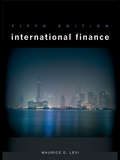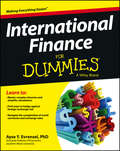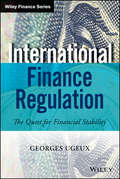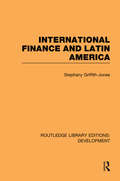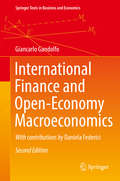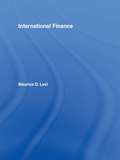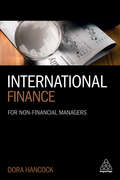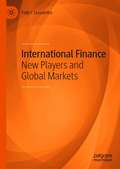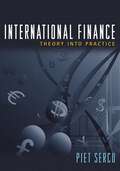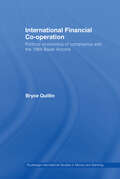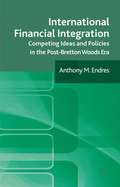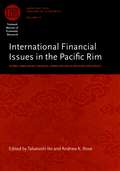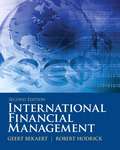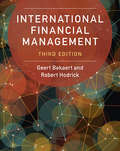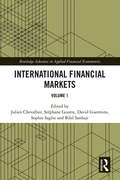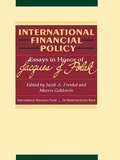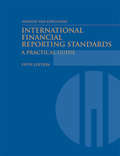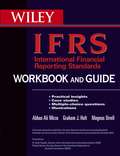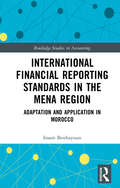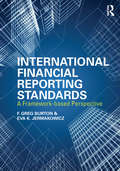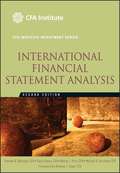- Table View
- List View
International Finance 5th Edition
by Maurice D. LeviThe fifth edition of Maurice D. Levi's classic textbook has been updated to incorporate the massive changes in the world of international finance of the past few years. In particular, the emergence of new markets is given broad coverage - particularly the rise to financial prominence of China and India and other growth economies in Asia and elsewhere. Key features of the book include: the impact of globalization and the greater connectedness of national economies and the world economy as a whole probably the best introduction to exchange rates available and how they directly impact upon firms as well as governments the continued massive impact of multinational corporations on the global financial scene as well as the opportunities presented by e-commerce. The material is interlaced with a wealth of supplementary material including real world case studies, review questions, examples and objectives. The result is the most authoritative survey of international finance currently available. Thoroughly updated and with a large amount of new information, this text will prove an indispensable guide to the inner workings of international finance to students of economics and business as well as professionals in the finance industry.
International Finance For Dummies
by Ayse EvrenselWant to get the most out of your International Finance course?Nowadays the value of daily foreign exchange trading is more than one hundred times the value of annual international trade in goods and services. As result of the great importance of international financial transactions, the subject of international finance continues to develop as fast as--or faster than--any other field in economics and finance. International Finance For Dummies sheds light on this increasingly important subject for the growing number of students required to take this course. If you're an undergraduate or MBA student enrolled in an international finance course, this hands-on, friendly guide gives you everything you need to succeed. Plus, it includes up-to-date information on the latest changes to International Finance Reporting Standards, its impact on a company's overall finances, and the various currencies and institutions available worldwide.Serves as an excellent supplement to your international finance textsProvides easy-to-understand explanations of complex materialBrings you up-to-speed on the concepts and subject matter you need to know International Finance For Dummies is your ticket to scoring your highest in your international finance course.
International Finance Regulation
by Georges UgeuxAs the global market expands, the need for international regulation becomes urgentSince World War II, financial crises have been the result of macroeconomic instability until the fatidic week end of September 15 2008, when Lehman Brothers filed for bankruptcy. The financial system had become the source of its own instability through a combination of greed, lousy underwriting, fake ratings and regulatory negligence. From that date, governments tried to put together a new regulatory framework that would avoid using taxpayer money for bailout of banks. In an uncoordinated effort, they produced a series of vertical regulations that are disconnected from one another. That will not be sufficient to stop finance from being instable and the need for international and horizontal regulation is urgent. This challenge is the focus of Georges Ugeux's book.International Finance Regulation: The Quest for Financial Stability focuses on the inspirations behind regulation, and examines the risks and consequences of fragmentation on a global scale. Author Georges Ugeux has four decades of experience in the legal and economic aspects of international business operations. He created and run the New York Stock Exchange'sinternational group in charge of developing the NYSE's reach to non-US companies, including relationships with regulators and governments. Ugeux teaches European Banking and Finance of the Columbia University School of Law. Ugeux is uniquely positioned to provide recommendations and suggestions from the perspective of a top global authority. In the book, he explores international regulation with topics such as:* Laws, regulations, and risks of overregulation* Transformation of the U.S. market and creation of the Eurozone* Development of a global framework and stability of the banking system* In-depth examination of Basel III, the Dodd-Frank Act, the European Banking Union, and the Volcker RuleThe book also contains case studies from real-world scenarios like Lehman, CDS, Greece, the London Whale, and Libor to illustrate the concepts presented. Finance consistently operates within an increasingly global paradigm, and an overarching regulation scheme is becoming more and more necessary for sustainable growth. International Finance Regulation: The Quest for Financial Stability presents an argument for collaboration toward a comprehensive global regulation strategy.
International Finance and Latin America (Routledge Library Editions: Development)
by Stephany Griffith-JonesThis reissue, initially published in 1984, examines the evolution of international financial flows to Latin America since 1945, along with their implications for National Development . The book describes how, in each of the first three decades since the war, a new agency emerged (foreign investors in the 1950s, official aid agencies in the 1960s and multinational banks in the 1970s) which was willing to play a dynamic role in generating new financial flows to the region. The lack of such an agent in the 1980s, combined with a reluctance on the part of former investors to maintain their level of assistance culminated in an economic debt crisis in Latin America which this work seeks to address, asking the crucial question: what measures should be taken – both nationally and internationally – to deal with this critical issue , in a way that will both encourage Latin American Development and avoid a major international financial crisis?
International Finance and Open-Economy Macroeconomics
by Giancarlo GandolfoThis rigorous textbook tames technicalities and makes even the most complex models accessible to students. Its unique two-tier structure makes the book attractive for undergraduates, graduates and researchers alike. In fact, the coverage is primarily directed to undergraduate students and is mainly confined to graphic analysis and to some elementary algebra. Further, each chapter has its own mathematical appendix, in which (i) the topics treated in the text are examined at a level suitable for advanced undergraduates, graduates and researchers, and (ii) generalizations and/or topics not treated in the text (including some at the cutting edge of research) are formally examined. The new edition has been thoroughly revised and updated to reflect the latest research on international finance. This book deals with the financial side of international economics and covers all aspects of international finance. There are many books and articles by exponents of alternative points of view. I know of no other book that provides the scope, balance, objectivity and rigor of this book. the late Professor Jerome L. Stein, Brown University This book is a second edition of a volume on international finance first published in 2001. Like Giancarlo's other books in International Economics, this book is organised as a two-books-in-one by distributing the material between text and appendices. The text provides coverage suitable for an undergraduate course while the mathematical appendices provide coverage of the topics at the frontier of the discipline and suitable for advanced undergraduate or graduate students in an international finance and international macroeconomics course. This edition updates the earlier volume and covers all the classic topics as well as the more recent advances in the theory and modelling of international finance. It includes some discussion of the empirical testing of these theories and where appropriate reference to the extensive empirical literature is also provided. This book is a valuable addition to the bookshelf of any serious International Finance Scholar and provides a treasure chest of material for any quality international finance course. Professor Pasquale M Sgro, Deakin University Giancarlo Gandolfo is one of the profession's most gifted textbook authors on mathematical modeling and international economics. His revised International Finance and Open-Economy Macroeconomics is remarkable for its scope and clarity. The book covers the older and intertemporal approaches, and topics that are usually left out of graduate treatments (the chapter on balance-of-payments accounting is a gem). Gandolfo's two-tier approach of first developing topics with graphs and basic algebra and then providing rigorous mathematics for each topic makes the book ideal for advanced undergraduate and graduate classes. Professor Michael D. Goldberg, University of New Hampshire
International Finance and Open-Economy Macroeconomics: Theory, History, and Policy
by Hendrik Van Den BergThis historically-based textbook on international finance and open-economy macroeconomics provides a complete course on the theory and policies that shaped our international financial system. Utilizing the 1944 Bretton Woods Conference as a unifying theme, the book covers all the standard topics of international finance, such as foreign exchange markets, balance of payments accounting, macroeconomic policy in an open economy, exchange rate crises, multinational enterprises, international banking, and the evolution of our international financial system. The detailed international financial theory is presented in a lively manner that reflects the close relationship between actual world events and the development of economic thought.The book also analyzes the causes of the 2008 international financial crisis and recession, encourages critical thinking about whether the current international financial system promotes human well-being, and concludes with a discussion on whether it is time to summon the world's financial leaders to another Bretton Woods Conference. In additional to providing students with a solid understanding of international finance and open-economy macroeconomics, the book is written in a reader-friendly style that makes it a good reference for anyone interested in the many fascinating issues related to our still-evolving global financial system and, more generally, our global economy.
International Finance: Contemporary Issues
by Maurice D. Levi Dilip DasIn this updated fourth edition, author Maurice Levi successfully integrates both the micro and macro aspects of international finance. He sucessfully explores managerial issues and focuses on problems arising from financial trading relations between nations, whilst covering key topics such as:* organization of foreign exchange markets* determination of exchange rates * the fundamental principles of international finance* foreign exchange risk and exposure* fixed and flexible exchange rates.This impressive new edition builds and improves upon the popular style and structure of the original. With new data, improved pedagogy, and coverage of all of the main developments in international finance over the last few years, this book will prove essential reading for students of economics and business.
International Finance: For Non-Financial Managers
by Dora HancockInternational Finance offers a clear and accessible introduction to the fundamental principles and practice of international finance in today's world, from the international financial environment and exchange rates, to financing multinational companies and international investment. The theory and techniques are presented with the non-financial manager in mind, and the theoretical material is supplemented by case studies and a discussion of the appropriateness of the various techniques and principles to solve practical problems. This book draws from examples and practice around the world, helping students of international corporate finance, particularly non-specialist finance students, understand the complexities of modern Europe and comparative systems of finance globally. International Finance is essential reading for anyone studying international finance or needing an up-to-date, engaging resource to help them navigate the complicated and ever-changing global financial world. Key theories and terms are explained and defined, avoiding unnecessary jargon and acknowledging that many readers are coming to the subject with little or no prior knowledge of corporate finance at all.
International Finance: New Players and Global Markets
by Felix I. LessamboThe landscape of international finance has drastically changed within the last decade. The institutions inherited from the Bretton-Woods conference—the IMF and the WBD— have become obsolete, in part, due to their lack of reforming. Meanwhile newly created institutions including The New Development Bank and the Asian Infrastructure Investment Bank are increasing their sphere of influence. Developing countries from Africa, Asia, and Latin America are more eager than ever to work with the NDB or the AIIB. Meanwhile, new players such as Sovereign Wealth Funds are reshaping financial markets, through their weights and influence in global markets. The book looks to enhance understanding of the real markets of international finance and proposes ways to bring the old and new players together in this sand-shifting world of international finance.
International Finance: Theory and Policy
by Steve SuranovicInternational Finance Theory and Policy is built on Steve Suranovic's belief that to understand the international economy, students need to learn how economic models are applied to real world problems. It is true what they say, that "economists do it with models." That's because economic models provide insights about the world that are simply not obtainable solely by discussion of the issues. International Finance Theory and Policy develops a unified model of the international macroeconomy. The text provides detailed descriptions of major macroeconomic variables, covers the interest rate parity and purchasing power parity theories of exchange rate determination, takes an exhaustive look at the pros and cons of trade imbalances and presents the well-known AA-DD model to explore the effects of fiscal and monetary policy under both fixed and flexible exchange rates. The models are developed, not by employing advanced mathematics, but rather by walking students through a detailed description of how a model's assumptions influence its conclusions. But more importantly, each model and theory is connected to real world policy issues. The Finance Text has the following unique features: o Begins with an historical overview of the international macroeconomy to provide context for the theory. o Concludes with a detailed discussion of the pros and cons of fixed and floating exchange rate systems. o Provides an extensive look at the issue of trade imbalances. Readers learn techniques to evaluate whether a country's trade deficit (or surplus) is dangerous, beneficial, or benign. o Explains how purchasing power parity is used to make cross country income comparisons. o Offers clear detailed explanations of the AA-DD model. o Applies the AA-DD model to understand the effects of monetary and fiscal policy on GDP, the exchange rate, and the trade balance.
International Finance: Theory into Practice
by Piet SercuInternational Finance presents the corporate uses of international financial markets to upper undergraduate and graduate students of business finance and financial economics. Combining practical knowledge, up-to-date theories, and real-world applications, this textbook explores issues of valuation, funding, and risk management. International Finance shows how theoretical applications can be brought into managerial practice. The text includes an extensive introduction followed by three main sections: currency markets; exchange risk, exposure, and risk management; and long-term international funding and direct investment. Each section begins with a short case study, and each of the sections' chapters concludes with a CFO summary, examining how a hypothetical chief financial officer might apply topics to a managerial setting. The book also contains end-of-chapter questions to help students grasp the material presented. Focusing on international markets and multinational corporate finance, International Finance is the go-to resource for students seeking a complete understanding of the field. Rigorous focus on international financial markets and corporate finance concepts An up-to-date and practice-oriented approach Strong real-world examples and applications Comprehensive look at valuation, funding, and risk management Introductory case studies and "CFO summaries," and end-of-chapter quiz questions Solutions to the quiz questions are available online
International Financial Co-Operation: Political Economics of Compliance with the 1988 Basel Accord (Routledge International Studies In Money And Banking Ser. #Vol. 47)
by Bryce QuillinThe Basel Accord - now commonly referred to as "Basel I" - has exerted a profound influence on international financial politics and domestic prudential financial sector regulatory policy yet great controversy has always surrounded the Accords impact on the safety and competitiveness of the worlds largest financial institutions and the evolution o
International Financial Integration
by Anthony M. EndresDrawing on prominent contributions by economists to the debate on international monetary reform, this book provides an historical perspective on the plans, schemes and ideas on the international financial system.
International Financial Issues in the Pacific Rim: Global Imbalances, Financial Liberalization, and Exchange Rate Policy
by Takatoshi Ito Andrew K. RoseThe imbalanced, yet mutually beneficial, trading relationship between the United States and Asia has long been one of international finance's most perplexing mysteries. Although the United States continues to post a substantial trade deficit-- and China reaps the benefits of a surplus-- the dollar has yet to sink in the face of ever-increasing account disparities. International Financial Issues in the Pacific Rim explains why the United States enjoys a seemingly symbiotic relationship with its trading partners despite stark inequities in the trade balance, especially with Asia. This timely and well-informed study also debunks the assumed link between economic openness and low inflation in the region, identifies the serious gap between academic and private-sector researchers' understanding of exchange rate volatility, and analyzes the liberalization of Asian capital accounts.International Financial Issues in the Pacific Rim will have broad implications for global trade and economic policy issues in Asia and beyond.
International Financial Management
by Cheol Eun Bruce G. Resnick Tuugi ChuluunInternational Financial Management provides students with a foundation for analysis through a text that is well-organized, comprehensive, and provides up-to-date coverage of the topics. Like the first nine editions, it is written based on two tenets: emphasis on the basics and emphasis on a managerial perspective. The scope and content of international finance has been fast evolving due to cycles of deregulations and regulations of financial markets, product innovations, and technological advancements. As capital markets of the world are becoming more integrated, a solid understanding of international finance has become essential for astute corporate decision making. Reflecting the growing importance of international finance as a discipline, we have seen a sharp increase in the demand for experts in the area in both the corporate and academic worlds. International Financial Management discussion is written so that a self-contained treatment of each subject is presented in a user-friendly fashion. The text is intended for use at both the advanced undergraduate and MBA levels.
International Financial Management
by Geert Bekaert Robert HodrickAn approach that blends theory and practice with real-world data analysis. International Financial Management seamlesslyblends theory with the analysis of data, examples, and practical case situations. Overall, Bekaert/Hodrick equips future business leaders with the analytical tools they need to understand the issues, make sound international financial decisions, and manage the risks that businesses may face in today's competitive global environment. All data in this edition has been updated to reflect the most recent information, including coverage on the latest research, global financial crisis, and emerging markets.
International Financial Management
by Geert Bekaert Robert HodrickThis new and fully updated edition of International Financial Management blends theory, data analysis, examples and practical case situations to equip students and business leaders with the analytical tools they need to make informed financial decisions and manage the risks that businesses face in today's competitive global environment. Combining theory and practice, the authors offer the reader a multitude of real-world examples and case studies, emphasising fundamental concepts, principles and analytical theories to enable students to understand not only what to do when confronted with an international financial decision, but why that choice is the correct one. Features include: real data analysis - all fully updated for the third edition; extended cases illustrating practical application of theory; point-counterpoints offering insight into contentious issues; concept boxes that explore and illustrate key concepts; and end-of-chapter questions. Suitable for M. B. A and advanced undergraduate business students taking a course in international financial management or international finance.
International Financial Management
by Jeff MaduraPrepare for success in international finance with this best-selling book's effective presentation of in-depth theory and practical applications. INTERNATIONAL FINANCIAL MANAGEMENT 12E builds on the fundamental principles of corporate finance to provide the timely information and contemporary insights needed to prosper in today's global business environment. This book discusses a wide range of managerial topics using a strong corporate perspective and highlights financial reform and its impact on the international finance today. An emphasis on the most recent financial industry trends further prepares readers to understand and effectively manage within the dynamic field of international finance.
International Financial Markets: Volume 1 (Routledge Advances in Applied Financial Econometrics)
by Julien Chevallier Stéphane Goutte David Guerreiro Sophie Saglio Bilel SanhajiThis book provides an up-to-date series of advanced chapters on applied financial econometric techniques pertaining the various fields of commodities finance, mathematics & stochastics, international macroeconomics and financial econometrics. International Financial Markets: Volume I provides a key repository on the current state of knowledge, the latest debates and recent literature on international financial markets. Against the background of the "financialization of commodities" since the 2008 sub-primes crisis, section one contains recent contributions on commodity and financial markets, pushing the frontiers of applied econometrics techniques. The second section is devoted to exchange rate and current account dynamics in an environment characterized by large global imbalances. Part three examines the latest research in the field of meta-analysis in economics and finance. This book will be useful to students and researchers in applied econometrics; academics and students seeking convenient access to an unfamiliar area. It will also be of great interest established researchers seeking a single repository on the current state of knowledge, current debates and relevant literature.
International Financial Policy
by International Monetary FundThis report reviews and assesses recent developments in the mature and emerging markets and continues the analysis of key structural changes in global financial markets that has been presented in previous reports. The survey generally covers the 12-month period ending in June 2000. Over this period global financial conditions in the main improved in tandem with the strong rebound of the global economy. Credit concerns have eased following the most severe market turbulence in the post war period and global investors became more willing to engage in risk taking. The continued rapid growth of US productivity - largely related to the 'new economy' - helped sustain the low inflation expansion in the United States, and spurred US and worldwide investment. Chapters in the report focus on emerging market financing; private sector involvement in crisis prevention and resolution; the role of foreign banks in emerging markets.
International Financial Reporting Standards
by HennieApplying International Financial Reporting Standards (IFRS) in a business situation can have a signficant effect on the financial results and position of a division or an entire business enterprise. 'International Financial Reporting Standards: A Practical Guide' gives private or public sector executives, managers, and financial analysts without a strong background in accounting the tools they need to participate in discussions and decisions on the appropriateness or application of IFRS. Each chapter summarizes an International Financial Reporting Standard, following a consistent structure: Objective of the Standard Scope of the Standard Key concepts Accounting treatment Presentation and disclosure Financial analysis and interpretation Many chapters of the book also contain examples that illustrate the practical application of key concepts in a particular standard. The publication includes all of the standards issued by the International Accounting Standards Board (IASB) through December 2008.
International Financial Reporting Standards (IFRS) Workbook and Guide
by Graham Holt Magnus Orrell Abbas A. MirzaInternational Financial Reporting Standards (IFRS) Workbook and Guide is a one stop resource for understanding and applying current International Financial Reporting Standards (IFRS) and offers: Easy-to-understand explanations of all IFRSs/IASs and IFRICs/SICs issued by the IASB/IASC up to March 2006 Illustrative examples Practical insights Worked case studies Multiple-choice questions with solutions Technically reviewed by Liesel Knorr, Secretary General of the German Accounting Standards Committee and former technical director of the International Accounting Standards Committee (IASC). Forewords by: Sir David Tweedie, Chairman of the International Accounting Standards Board (IASB) Philippe Richard, Secretary General of the International Organization of Securities Commissions (IOSCO)
International Financial Reporting Standards in the MENA Region: Adaptation and Application in Morocco (Routledge Studies in Accounting)
by Issam BenhayounIn the ever-evolving landscape of global economics, accounting stands as the universal language of business. This book explores the vital role of accounting in articulating economic, social, and environmental activities. It provides a detailed comparison among Moroccan GAAP, IFRS, and US GAAP, highlighting the challenges and opportunities of harmonizing accounting standards in the context of Morocco's unique business environment.Each chapter is crafted to offer practical guidance and technical insights. From property, plant, and equipment (IAS 16) to intangible assets (IAS 38), leases (IAS 17), and inventory valuation (IAS 2), International Financial Reporting Standards in the MENA Region: Adaptation and Application in Morocco covers essential standards with a focus on their real-world applications. Special emphasis is placed on the preparation of cash flow statements (IAS 7), a crucial aspect often overlooked in the Moroccan accounting framework.Through practical case studies and comparative analyses, readers will gain a comprehensive understanding of the principles governing financial statements and the importance of transparency and investor confidence. This book is an indispensable resource for accounting professionals, academics, and anyone interested in the global standardization of financial reporting.
International Financial Reporting Standards: A Framework-Based Perspective
by Greg F. Burton Eva K. JermakowiczInternational Financial Reporting Standards: A Framework-based Perspective links broad concepts and general accounting principles to the specific requirements of IFRS to help students develop and understand the judgments required in using a principle-based standard. Although it is still unclear whether the US will adopt IFRS, the global business environment makes it necessary for accounting students and professionals to be bilingual in both US GAAP and IFRS. This comprehensive textbook offers: A clear presentation of the concepts underlying IFRS A conceptual framework to guide students in interpreting and applying IFRS rules A comparison between IFRS and US GAAP to develop students’ understanding of the requirements of each standard Real world examples and case studies to link accounting theory to practice, while also exposing students to different interpretations and applications of IFRS End of chapter material covering other aspects of financial reporting, including international auditing standards, international ethics standards, and corporate governance and enforcement, as well as emerging topics, such as integrated accounting, sustainability and social responsibility accounting and new forms of financial reporting Burton & Jermakowicz have crafted a thorough and extensive tool to give students a competitive edge in understanding, and applying IFRS. A companion website provides additional support for both students and instructors.
International Financial Statement Analysis
by Elaine Henry Thomas R. Robinson Michael A. Broihahn Anthony T. Cope Wendy L. PirieUp-to-date information on using financial statement analysis to successfully assess company performance, from the seasoned experts at the CFA InstituteDesigned to help investment professionals and students effectively evaluate financial statements in today's international and volatile markets, amid an uncertain global economic climate, International Financial Statement Analysis, Second Edition compiles unparalleled wisdom from the CFA in one comprehensive volume.Written by a distinguished team of authors and experienced contributors, the book provides complete coverage of the key financial field of statement analysis. Fully updated with new standards and methods for a post crisis world, this Second Edition covers the mechanics of the accounting process; the foundation for financial reporting; the differences and similarities in income statements, balance sheets, and cash flow statements around the world; examines the implications for securities valuation of any financial statement element or transaction, and shows how different financial statement analysis techniques can provide valuable clues into a company's operations and risk characteristics.Financial statement analysis allows for realistic valuations of investment, lending, or merger and acquisition opportunitiesEssential reading for financial analysts, investment analysts, portfolio managers, asset allocators, graduate students, and others interested in this important field of financeIncludes key coverage of income tax accounting and reporting, the difficulty of measuring the value of employee compensation, and the impact of foreign exchange rates on the financial statements of multinational corporationsFinancial statement analysis gives investment professionals important insights into the true financial condition of a company, and International Financial Statement Analysis, Second Edition puts the full knowledge of the CFA at your fingertips.
